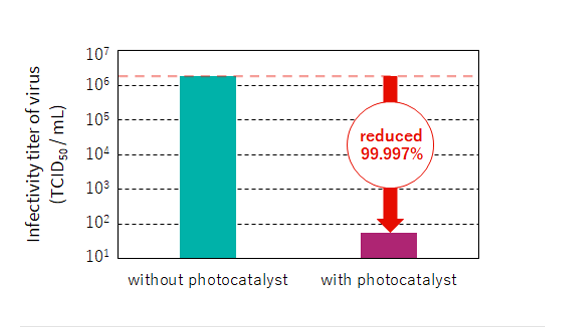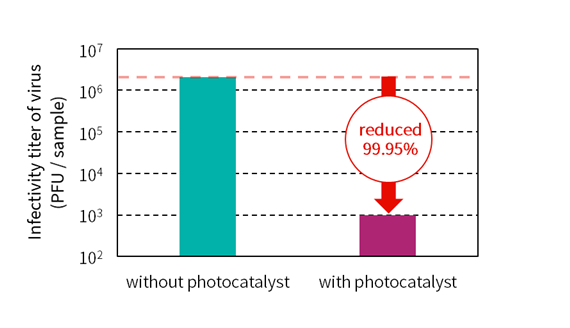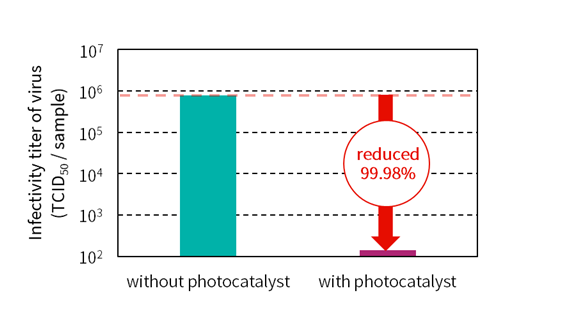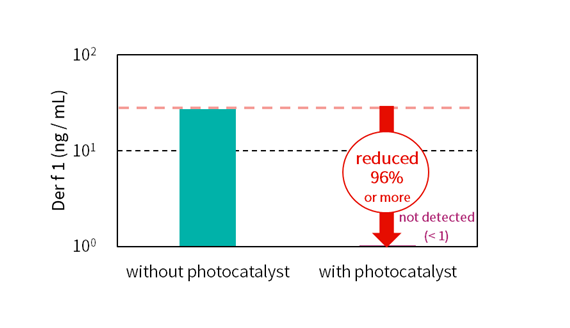Sharp Photocatalytic TechnologyEffects and Safety
Effects
Learn about the proven effects demonstrated through third-party testing.
Antiviral
Novel coronavirus
The infectivity titer of virus*1 after 2 hours of inoculation on the sheet with photocatalyst was reduced by 99.997%*2compared with the sheet without photocatalyst.

- Test lab
- Biostir Inc.
- Supervisor
- Professor Hironori Yoshiyama, Faculty of Medicine, Shimane University
- Test report No.
- 15-an-SHPPC-2
- Test method
- With reference to JIS R 1756:2020
- Test conditions
- White LED 1,000 lx illumination for 2 hours
- Test virus
- Novel coronavirus, SARS-CoV-2/JP/Hiroshima-46059T/2020
- *1 A value that represents the infectivity of a virus to infect cells
- *2 Converted value by Sharp based on the test result
Novel coronavirus (Omicron Variant)
The infectivity titer of virus*1after 24 hours of inoculation on the glass plate with photocatalyst coating was reduced by 99.98% or more*2compared with the glass plate without photocatalyst coating to an undetectable level.

- Test lab
- Indian Institute of Science (IISc)
- Test report No.
- CP 9238/0304/2021
- Test method
- With reference to JIS R 1756:2020
- Test conditions
- White LED 1,000 lx illumination for 24 hours
- Test virus
- Novel coronavirus, SARS-CoV-2 Omicron Variant(Isolate hCoV-19/USA/MD- HP20874/2021,Lineage B.1.1.529;Omicron variant NR-56461, BEI Resources, NIAID, NIH)
- *1 A value that represents the infectivity of a virus to infect cells
- *2 Converted value by Sharp based on the test result
Bacteriophage Qβ
The infectivity titer of virus*1 after 4 hours of inoculation on the sheet with photocatalyst was reduced by 99.95%*2 compared with the sheet without photocatalyst.

- Test lab
- Kanagawa Institute of Industrial Science and Technology
- Test report No.
- KISTEC03-016A02
- Test method
- With reference to JIS R 1756:2020, film cover method
- Test conditions
- Fluorescent light 500 lx (wavelength 380 nm or less was cut) illumination for 4 hours
- Test virus
- Bacteriophage Qβ, NBRC 20012
- *1 A value that represents the infectivity of a virus to infect cells
- *2 Converted value by Sharp based on the test result
Feline enteric coronavirus
The infectivity titer of virus after 24 hours of inoculation on the nonwoven fabric with photocatalyst was reduced by 99.98% compared with the nonwoven fabric without photocatalyst.

- Test lab
- Kitasato Research Center for Environmental Science
- Test report No.
- 2020_0109
- Test sample
- Photocatalytic nonwoven fabrics
- Test method
- With reference to JIS R 1756:2020
- Test conditions
- White LED 500 lx illumination for 24 hours
- Test virus
- Feline enteric coronavirus, WSU 79-1683
Antibacterial
Staphylococcus aureus
Number of viable bacteria after 24 hours of inoculation on the sheet with photocatalyst was reduced by 99.99% or more* compared with the sheet without photocatalyst to an undetectable level.

- Test lab
- Japan Food Research Laboratories
- Test report No.
- 15064805001-0101
- Test method
- With reference to JIS R 1752:2013
- Test conditions
- Fluorescent light 1,000 lx (wavelength 380 nm or less was cut) illumination for 24 hours
- Test bacteria
- Staphylococcus aureus subsp. aureus, NBRC 12732
- * Converted value by Sharp based on the test result
Escherichia coli
Number of viable bacteria after 24 hours of inoculation on the sheet with photocatalyst was reduced by 99.99% or more* compared with the sheet without photocatalyst to an undetectable level.

- Test lab
- Japan Food Research Laboratories
- Test report No.
- 15064805001-0101
- Test method
- With reference to JIS R 1752:2013
- Test conditions
- Fluorescent light 1,000 lx (wavelength 380 nm or less was cut) illumination for 24 hours
- Test bacteria
- Escherichia coli, NBRC 3972
- * Converted value by Sharp based on the test result
Salmonella typhimurium
Number of viable bacteria after 30 minutes was reduced by 99.99% or more to an undetectable level.

- Test lab
- TUV SUD South Asia Pvt. Ltd.
- Test report No.
- GGN/F(M)/21/004952
- Test method
- Onto glass slides inoculated bacterial suspension and added photocatalyst liquid. Took samples at the initial and after illumination for 30 minutes and counted the number of viable bacteria.
- Test conditions
- White LED 1,000 lx illumination
- Test bacteria
- Salmonella typhimurium
Shigella flexneri
Number of viable bacteria after 24 hours was reduced by 97.17%.

- Test lab
- TUV SUD South Asia Pvt. Ltd.
- Test report No.
- GGN/F(M)/21/004952
- Test method
- Onto glass slides inoculated bacterial suspension and added photocatalyst liquid. Took samples at the initial and after illumination for 24 hours and counted the number of viable bacteria.
- Test conditions
- White LED 1,000 lx illumination
- Test bacteria
- Shigella flexneri
Anti-allergenic
Allergen derived from mites
Activity of allergen after 24 hours in solution with photocatalyst was reduced by 96% or more* compared with solution without photocatalyst to an undetectable level.

- Test lab
- Biostir Inc.
- Test report No.
- 14-an-SHP-5
- Test method
- After light irradiation to the mixed solution of photocatalyst and Derf1, the activity of allergen was measured by ELISA method.
- Test conditions
- White LED 1,000 lx illumination for 24 hours
- Test allergens
- Allergen derived from mites (Der f 1)
- * Converted value by Sharp based on the test result
Allergen derived from cedar pollen
Activity of allergen after 1 hours in solution with photocatalyst was reduced by 99.96% or more * compared with solution without photocatalyst to an undetectable level.

- Test lab
- Biostir Inc.
- Test report No.
- 15-an-SHPPC-1
- Test method
- After light irradiation to the mixed solution of photocatalyst and Cry j 1, the activity of allergen was measured by ELISA method.
- Test conditions
- White LED 1,000 lx illumination for 1 hours
- Test allergens
- Allergen derived from cedar pollen (Cry j 1)
- * Converted value by Sharp based on the test result
Antifungal
Cladosporium
Under fluorescent light 500 lx (wavelength 380 nm or less was cut), no mold growth was detected by visual observation even after 4 weeks.
| Without irradiation | With irradiation |
|---|---|
 |
 |
- Test lab
- Hygiene & Microbiology Research Center
- Test report No.
- 2018D-BT-418
- Test method
- With reference to JIS Z 2911:2010, JIS R 1705:2016
- Test mold
- Cladosporium cladosporioides, NBRC6348
Safety
Learn about the proven safety demonstrated through third-party testing.
| Test item | Test results | Test lab |
|---|---|---|
| Acute oral toxicity test | Out of category | Frey-Tox (Germany) |
| Skin irritation test | Negative | Frey-Tox (Germany) |
| Mutagenicity (Ames test) |
Negative | NISSEI BILIS (Japan) |
| Skin sensitization test | Negative | Fraunhofer (Germany) |
